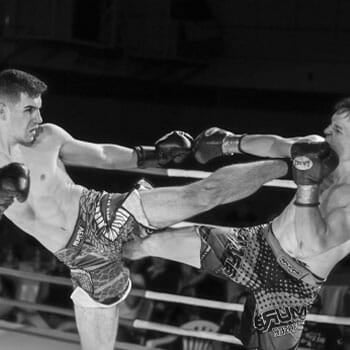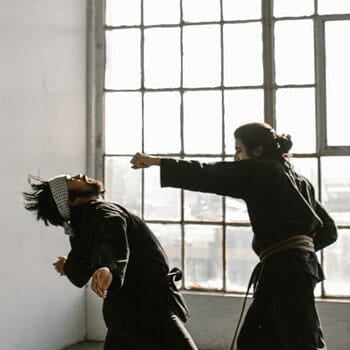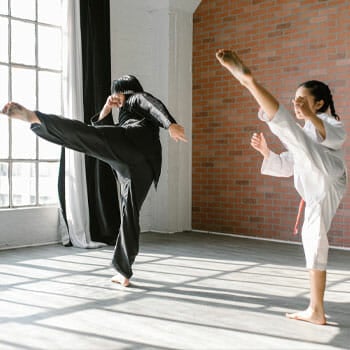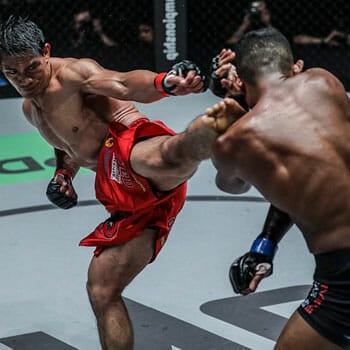Many people believe that kickboxing and Muay Thai are the same.
Although these two martial arts share many similarities, they’re actually different in many ways.
Differentiating one sport from another can be hella confusing, so as an ex-MMA fighter and kickboxing champion, I created this comparison to help you tell which is which.
Let’s get to it.
Quick Summary
- Kickboxing and Muay Thai differ mainly in techniques, with Muay Thai using an 8-point striking system and kickboxing focusing more on footwork and punching.
- Muay Thai employs punches, kicks, knees, and elbows, while kickboxing draws more from Western boxing techniques and footwork.
- A study from the National Center for Biotechnology Information found that 22.7% of amateur kickboxers have growth hormone deficiency, and 9.1% have ACTH deficiency, indicating that kickboxing can cause traumatic brain injury (TBI).
- In my experience, both martial arts offer unique advantages, and the choice between them depends on individual preferences and fighting style.
The Fundamentals Of Muay Thai

Muay Thai, aka Thai boxing, is a combat sport with an 8-point striking system. Its entire focus is on generating explosive blows using movements such as punches, kicks, knees, and elbows.
Powerful leg kicks are designed to damage an opponent’s thigh and calf muscles, while sharp elbow strikes are used to open up cuts in an opponent’s face. The clinch, where a fighter grapples the opponent, is a move meant to gain control of the fight and limit the damage one incurs.
It’s also an excellent strategy for landing damaging elbows and knees from close quarters.
According to one of the studies from the National Center for Biotechnology Information website, Muay Thai athletes demonstrated a very high strength of association between training experience and performance in five strength tests, indicating a significant correlation between their training intensity and strength development [1].
The Fundamentals of Kickboxing

As an ex-National Soccer player turned MMA and Kickboxing champion, I've experienced firsthand the nuances and intricacies of various combat sports. Kickboxing, while employing techniques similar to pure boxing, offers a unique blend that makes a skilled kickboxer adept at handling opponents in a boxing ring under typical boxing rules.
This sport, a 4-point striking system, not only utilizes punches and kicks but places a significant emphasis on footwork and movement. From my extensive training and competition experience, I can attest that kickboxers are often trained to circle and advance in and out with ease, a testament to the sport's focus on dynamic movement.
Moreover, kickboxing is known for integrating a wide range of exotic strikes, such as axe kicks and spin kicks, adding to its versatility and unpredictability in combat scenarios.
Another study from the National Center for Biotechnology Information website investigated pituitary functions in amateur kickboxers and demonstrated that kickboxing is a cause of TBI and that growth hormone (GH) deficiency and adrenocorticotropic hormone (ACTH) deficiency were also very common (22.7%, 9.1%, respectively) among 22 amateur kickboxers [2].
Related Articles:
Notable Differences Between Muay Thai And Kickboxing
The Boxing

Kickboxing, particularly K-1 and Dutch kickboxing, takes many of its techniques from western boxing.
Kickboxing often involves heavy use of hands, sometimes even more than kicks, while Muay Thai especially the traditional Muay Thai in Thailand uses far more kicking.
Muay Thai fighters often clinch, knee, and elbow their opponents.
You won’t see these moves in kickboxing, making it easier to engage in punching without worrying about these charges.
Kickboxing also has longer hand combos, usually three to six punch combos.
The Kicking Technique

Both the low kicks and high kicks for these two combat sports are completely different.
But Muay Thai fighters competing under K-1 rules sometimes use kicks practiced in some kickboxing styles such as Dutch kickboxing.
However, there is still a general difference, especially when you compare American kickboxing and Muay Thai.
Kickboxing fighters swing their hips, lift their legs, and snap their knee when throwing kicks.
They prefer to land with their feet, but some may also land with the middle/lower part of their shin.
Unlike kickboxers, Muay Thai fighters don't bend their knee while kicking.
They keep their leg relaxed until the moment of impact, the point of which is at the lower part of the shin.
This tactic allows them to land with more speed.
This move's power is driven by the torque of the hip and arms as fighters swing their opposite arm downwards while twisting their hip.
Footwork

If you've ever seen a kickboxing fight, you'll notice how its rhythm of movement differs from Muay Thai.
Muay Thai fighters are not as shifty and mobile as kickboxers.
The former requires more patience; they wait for the right opening before they strike and aggressively advance forward.
This is the complete opposite of mixed martial arts or kickboxing, where fighters intimidate each other with an active use of hands, angles, movements, and volume combos.
Although you can fight like this in Muay Thai, the sport's top fighters rely mostly on quick and explosive counter-attacks.
Head Movement

There is minimal head movement, circling, and weaving in Muay Thai fights compared to kickboxing.
On the other hand, kickboxing fighters may duck, bob, weave and slip punches as a boxer would.
Watch any K-1 fight, and you will see how competitors move both their heads and feet to dodge punches.
“I fear not the man who has practiced 10,000 kicks once, but I fear the man who has practiced one kick 10,000 times.”
- Bruce Lee, Martial Artist
Striking Techniques

Even though Muay Thai and kickboxing share the same punches, knees, and kicks—like round kicks and leg kicks—they differ in a few striking techniques.
Since kickboxing takes some of its movements from karate, it tends to have a broader range of kick styles, like the axe kick, side kick, spin kick, and other unique attacks.
You're more likely to see spinning kicks in a K-1 match more than other kicks, but it still depends on the fighter, of course.
Conversely, spinning kicks are rarely performed in traditional Muay Thai, but their fancy form is present in Muay Boran, the art form of Muay Thai.
Staple kicks in Muay Thai include the Teep or the front push kick used to create distance or deliver a powerful strike.
A Muay Thai fighter can also pull off fancy moves such as the cartwheel kick, the spinning elbow, and the spinning back fist.
Fight Pace

Traditional Muay Thai, as found in Thailand, consists of five-round fights, with the first two rounds being "soft."
This is the stage when fighters feel out their opponent.
The real fight begins during round three when both fighters really start attacking each other.
On the other hand, kickboxing fights tend to be pretty intense from the start.
Each match is three rounds in duration, and opponents typically fight hard in every round

FAQs
Which Is Better, Kickboxing or Muay Thai?
Those in the know would say that Muay Thai is better for combat as it offers fighters more ways to attack, which kickboxing doesn't.
This martial art incorporates the use of elbows, knees, and clinch work.
Others think that kickboxing is better because of its emphasis on footwork, movement, and boxing skills.
Although they differ in fighting style, the reality is that both of these arts can learn from one another.
There are many styles of kickboxing, and some of these fighting styles can be equal in their effectiveness to Muay Thai.
Which Is More Dangerous, Boxing or Muay Thai?
Boxing is considered more dangerous than Muay Thai because most strikes in this sport are aimed at the head.
The number of rounds in one fight is also usually higher than in Muay Thai.
Muay Thai tends to be safer because it has a lighter sparring style.
Muay Thai fighters also take fewer hits to the head than boxers due to the lower number and shorter length of rounds during an average match.
What Are the Historical Origins and Evolution of Kickboxing and Muay Thai?
Kickboxing and Muay Thai have rich histories, with Kickboxing originating from Japan and combining elements of Karate and Boxing. In contrast, Muay Thai, also known as Thai Boxing, has its roots in Thailand as a traditional combat form. Over time, both martial arts have evolved, with Muay Thai maintaining more traditional elements and Kickboxing adopting various global influences.
How Do the Stances and Movements Differ Between Kickboxing and Muay Thai?
In Kickboxing, stances and movements often emphasize agility and quick footwork, similar to Western Boxing. At the same time, Muay Thai focuses on a more stable and grounded stance, allowing for powerful kicks and knee strikes. These differences significantly impact the fighting techniques and strategies used in each martial art.
What Are the Psychological Aspects of Training in Kickboxing Versus Muay Thai?
Training in Kickboxing often develops quick decision-making and adaptability, given its fast-paced nature, while Muay Thai training emphasizes mental resilience and discipline, reflecting its traditional combat roots. Both disciplines cultivate focus and mental toughness, essential for martial arts proficiency.
How Have Kickboxing and Muay Thai Influenced Modern Mixed Martial Arts (MMA)?
Elements of Kickboxing and Muay Thai are integral in modern MMA, with fighters incorporating Kickboxing's diverse striking techniques and Muay Thai's clinch work and elbow/knee strikes. This blend of styles has led to a more dynamic and versatile approach to MMA fighting.
What Is the Cultural Significance and Global Popularity of Kickboxing and Muay Thai?
Muay Thai holds deep cultural significance in Thailand, symbolizing national pride and tradition. At the same time, Kickboxing has gained global popularity, appealing to those seeking a blend of Eastern and Western fighting techniques. Both martial arts enjoy a strong following worldwide, each with its unique cultural impact and appeal.
References:
- https://www.ncbi.nlm.nih.gov/pmc/articles/PMC9322178/
- https://www.ncbi.nlm.nih.gov/pmc/articles/PMC5424459/
About The Author
You May Also Like






